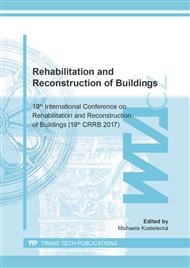[1]
A. M. Neville, Properties of concrete, fifth ed., Pearson, New York, (2011).
Google Scholar
[2]
Ch. H. Lee, K. Clark Hover, A. Lee, Difference in Setting Behavior between Prepared and Sieved Mortars in the ASTM C403 Time of Setting Test, Journal of Testing and Evaluation. 43 (2015), 4.
DOI: 10.1520/jte20130301
Google Scholar
[3]
ČSN EN 196-3, Methods of testing cement - Part 3: Determination of setting times and soundness, ÚNMZ, Praha, 2007 (in Czech).
Google Scholar
[4]
ČSN 73 1332, Determination of concrete setting time, ÚNM, Praha, 1986 (in Czech).
Google Scholar
[5]
ASTM C191-13, Standard Test Methods for Time of Setting of Hydraulic Cement by Vicat Needle, ASTM International, West Conshohocken, PA, (2013).
Google Scholar
[6]
ASTM C403 / C403M - 16. Standard Test Method for Time of Setting of Concrete Mixtures by Penetration Resistance, ASTM International, West Conshohocken, PA, (2016).
Google Scholar
[7]
Schleibinger Testing Systems: Ultrasonic Setting Measurement [online], Schleibinger Gerate, Germany, 2017, http://www.schleibinger.com/cmsimple/en/?Setting_and_Maturity:Ultrasonic_ Setting_Measurement.
Google Scholar
[8]
ČSN EN 196-1, Methods of testing cement – Part 1: Determination of strength, ÚNMZ, Praha, 2016 (in Czech).
Google Scholar
[9]
ČSN EN 1015-3, Methods of test for mortar for masonry - Part 3: Determination of consistence of fresh mortar (by flow table), ÚNMZ, Praha, 2000 (in Czech).
DOI: 10.3403/01541440
Google Scholar
[10]
ČSN EN 12504-4, Testing concrete - Part 4: Determinatin of ultrasonic pulse velocity, ČNI, Praha, 2005 (in Czech).
Google Scholar
[11]
Českomoravský cement: Heidelberg Cement Group [online], Mokrá, 2016, http://www.heidelbergcement.cz/cs/cement/volne-lozeny-cement/cemi525r.
Google Scholar
[12]
ČSN EN 480-2, Admixtures for concrete, mortar and grout - Test methods - Part 2: Determination of setting time, ČNI, Praha, 2007 (in Czech).
DOI: 10.3403/01038781
Google Scholar
[13]
H. W. Reinhardt, C. U. Grosse, Advanced testing of cement based materials during setting and hardening, RILEM Publications, Bagneux, France, (2005).
Google Scholar
[14]
J. Tanesi, A. Ardani, Isothermal Calorimetry as a Tool to Evaluate Early-Age Performance of Fly Ash Mixtures, Transportation Research Record: Journal of the Transportation Research Board. 2342 (2013), 42-53.
DOI: 10.3141/2342-06
Google Scholar
[15]
Calmetrix: Application Note AN-C06: Setting time estimation and prediction using isothermal calorimetry, USA, 2015, http://downloads.calmetrix.com/Application/AN-C06-Setting-Time-Prediction.pdf.
Google Scholar


